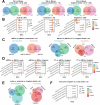Ischemic stroke-related gene expression profiles across species: a meta-analysis
- PMID: 37337154
- PMCID: PMC10280959
- DOI: 10.1186/s12950-023-00346-x
Ischemic stroke-related gene expression profiles across species: a meta-analysis
Abstract
Stroke patients are often left with permanent disabilities with no regenerative treatment options. Unbiased RNA sequencing studies decoding the transcriptional signature of stroked tissue hold promise to identify new potential targets and pathways directed to improve treatment for stroke patients. Here, gene expression profiles of stroked tissue across different time points, species, and stroke models were compared using NCBI GEO database. In total, 34 datasets from mice, rats, humans, and primates were included, exploring gene expression differences in healthy and stroked brain tissue. Distinct changes in gene expression and pathway enrichment revealed the heterogenicity of the stroke pathology in stroke-related pathways e.g., inflammatory responses, vascular repair, remodelling and cell proliferation and adhesion but also in diverse general, stroke-unrelated pathways that have to be carefully considered when evaluating new promising therapeutic targets.
Keywords: Animal models; Gene expression; Gene ontology; Hypoxia; Ischemia; Meta analysis; Preclinical research; Stroke; Transcriptomics.
© 2023. The Author(s).
Conflict of interest statement
The authors declare no competing interests.
Figures


Similar articles
-
Transcriptome profiling revealed early vascular smooth muscle cell gene activation following focal ischemic stroke in female rats - comparisons with males.BMC Genomics. 2020 Dec 9;21(1):883. doi: 10.1186/s12864-020-07295-2. BMC Genomics. 2020. PMID: 33297959 Free PMC article.
-
Molecular and anatomical roadmap of stroke pathology in immunodeficient mice.Front Immunol. 2022 Dec 9;13:1080482. doi: 10.3389/fimmu.2022.1080482. eCollection 2022. Front Immunol. 2022. PMID: 36569903 Free PMC article.
-
Prognostic Signature for Human Umbilical Cord Mesenchymal Stem Cell Treatment of Ischemic Cerebral Infarction by Integrated Bioinformatic Analysis.Biomed Res Int. 2022 Dec 13;2022:9973232. doi: 10.1155/2022/9973232. eCollection 2022. Biomed Res Int. 2022. PMID: 36560962 Free PMC article.
-
Regenerative therapy for stroke.Cell Transplant. 2007;16(2):171-81. Cell Transplant. 2007. PMID: 17474298 Review.
-
Cell Heterogeneity Uncovered by Single-Cell RNA Sequencing Offers Potential Therapeutic Targets for Ischemic Stroke.Aging Dis. 2022 Oct 1;13(5):1436-1454. doi: 10.14336/AD.2022.0212. eCollection 2022 Oct 1. Aging Dis. 2022. PMID: 36186129 Free PMC article. Review.
Cited by
-
Photobiomodulation Promotes Early Recovery of Olfactory Function and Modulates Neuroprotective Gene Expression in a Mouse Model of Ischemic Stroke.Transl Stroke Res. 2025 Oct;16(5):1723-1732. doi: 10.1007/s12975-025-01343-3. Epub 2025 May 13. Transl Stroke Res. 2025. PMID: 40358915
-
The blood-brain barrier: a help and a hindrance.Brain. 2025 Jul 7;148(7):2262-2282. doi: 10.1093/brain/awaf068. Brain. 2025. PMID: 39969549 Free PMC article. Review.
-
Effectiveness and brain mechanism of multi-target transcranial alternating current stimulation (tACS) on motor learning in stroke patients: study protocol for a randomized controlled trial.Trials. 2024 Jan 30;25(1):97. doi: 10.1186/s13063-024-07913-4. Trials. 2024. PMID: 38291500 Free PMC article.
-
A molecular brain atlas reveals cellular shifts during the repair phase of stroke.bioRxiv [Preprint]. 2024 Aug 22:2024.08.21.608971. doi: 10.1101/2024.08.21.608971. bioRxiv. 2024. Update in: J Neuroinflammation. 2025 Apr 18;22(1):112. doi: 10.1186/s12974-025-03437-z. PMID: 39229128 Free PMC article. Updated. Preprint.
-
Transcriptomics and translatomics identify a robust inflammatory gene signature in brain endothelial cells after ischemic stroke.J Neuroinflammation. 2023 Sep 11;20(1):207. doi: 10.1186/s12974-023-02888-6. J Neuroinflammation. 2023. PMID: 37691115 Free PMC article.
References
LinkOut - more resources
Full Text Sources

